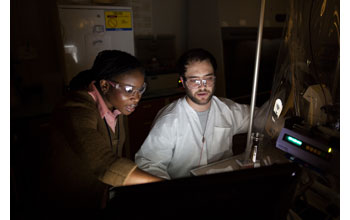Multimedia Gallery
Researching New Drug Carriers (Image 4)
Chemical engineering professor Omolola Eniola-Adefeso and Ph.D. student Alex Thompson discuss the results of an experiment determining how well potential drug carriers bind to blood vessel walls. The research is carried out at Eniola-Adefeso's lab at the University of Michigan, Ann Arbor. (Date of Image: 2006) [Image 4 of 4 related images. Back to Image 1.]
More About This Image
Medical researchers have been investigating ways in which drug-carrying nanoparticles can navigate tissues and the interiors of cells. Drug delivery systems would allow more precise targeting of diseased tissue, thus making medicines more effective and requiring lower doses with fewer side effects. However, Eniola-Adefeso and her team have found a problem: the particles cannot escape the bloodstream.
With their tiny size--less than 1 micron in diameter, or one-thousandth of a millimeter--nanoparticles are considered a promising drug carrier. Their tiny size lets them slip through cracks between cells and penetrate cell membranes, where they can begin administering medicine. However, once the nanoparticles get in the bloodstream, it is very hard for them to exit.
In the body, blood vessels are like highways, and once the nanoparticles get into the flow, they find it very hard to reach an exit. In all vessels other than capillaries, the red cells in flowing blood tend to come together in the center. "The red blood cells sweep those particles that are less than 1 micron in diameter and sandwich them," says Eniola-Adefeso. The nanoparticles become trapped among the red cells, unable to reach the vessel wall to treat the disease in the blood vessels and tissue.
Eniola-Adefeso and her team have found that nanoparticle spheres cannot exit blood vessels, from tiny arterioles and venules--which are a step up from capillaries--all the way up to centimeter-sized arteries. Their findings are the first visual evidence that very few nanospheres make it to the actual vessel wall in blood flow.
A small number of nanospheres do filter out to the blood vessel walls, but many more stay in the bloodstream and travel throughout the body. The researchers found that increasing the dose did not improve the problem. They tried adding five times more nanospheres to the blood samples but the number of spheres that bonded with the blood vessel lining only doubled.
"Prior to the work that we have done, people were operating under the assumption that particles will interact with the blood vessel at some point," Eniola-Adefeso said. "If localized drug delivery is an important goal, then nanospheres will fail."
While these results are discouraging, Eniola-Adefeso's group did find, however, that red blood cells tend to push microspheres with diameters of 2 microns or more toward the wall. The larger microspheres were able to reach the vessel wall and bind to it, regardless of whether the blood flowed evenly, as in arterioles and venules, or in pulses, as in arteries. The team saw a relative increase in microspheres on vessel walls when they added more microspheres to the flow.
Microspheres are too large to act as drug carriers into cells or tissue on their own; however, the team believes the microspheres could possibly carry the nanospheres to the vessel wall and release them once they're attached. Or perhaps a different shape of nanoparticle might work. The team is currently researching the use of rod-shaped nanoparticles.
This research was funded by the National Science Foundation (grant DUE 11-04305) and the American Heart Association.
Credit: Joseph Xu, Michigan Engineering Communications and Marketing
Images and other media in the National Science Foundation Multimedia Gallery are available for use in print and electronic material by NSF employees, members of the media, university staff, teachers and the general public. All media in the gallery are intended for personal, educational and nonprofit/non-commercial use only.
Images credited to the National Science Foundation, a federal agency, are in the public domain. The images were created by employees of the United States Government as part of their official duties or prepared by contractors as "works for hire" for NSF. You may freely use NSF-credited images and, at your discretion, credit NSF with a "Courtesy: National Science Foundation" notation.
Additional information about general usage can be found in Conditions.
Also Available:
Download the high-resolution JPG version of the image. (16 MB)
Use your mouse to right-click (Mac users may need to Ctrl-click) the link above and choose the option that will save the file or target to your computer.



